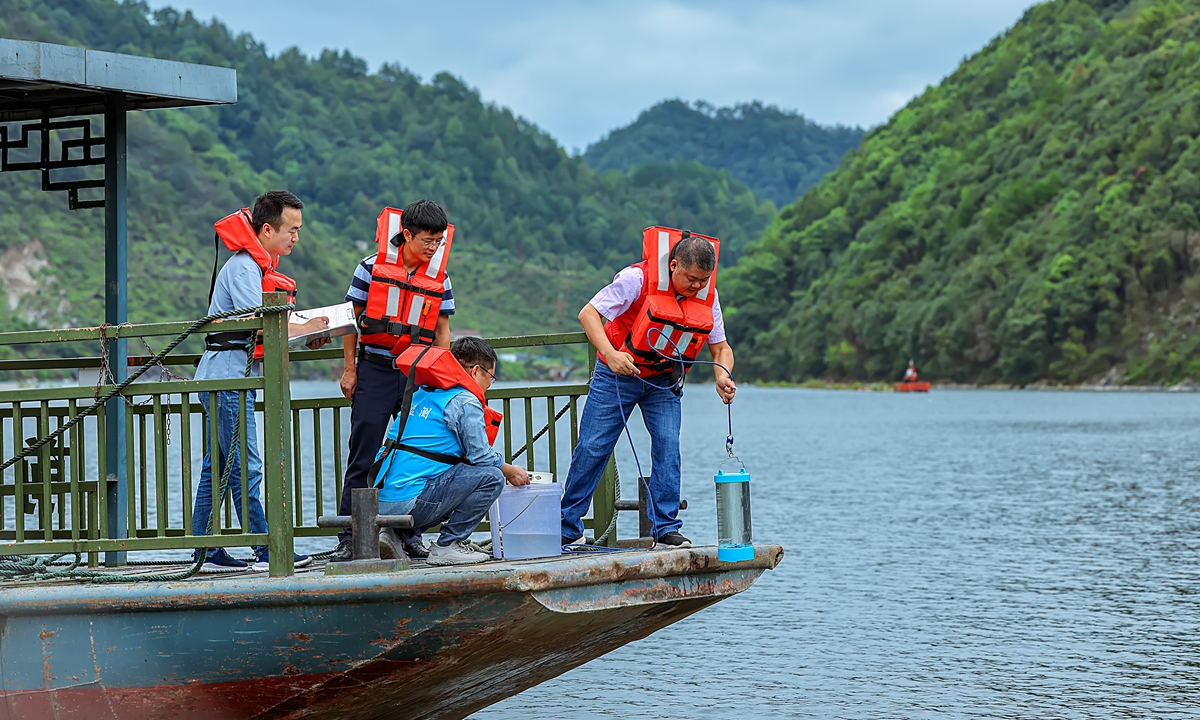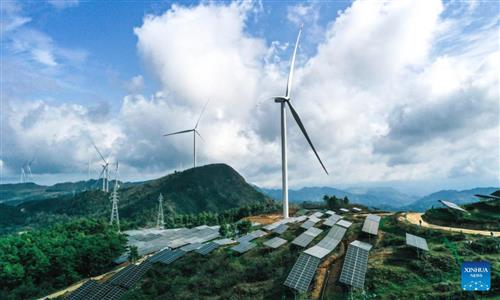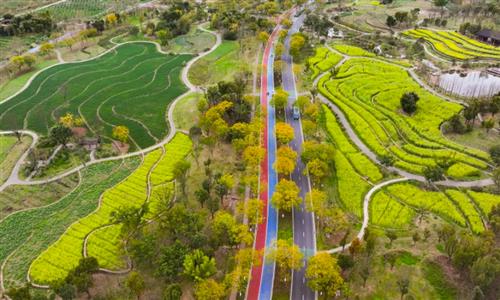
Environmental department workers from Chun’an county of Zhejiang and Shexian county of Anhui take samples from the Xin’an River during a joint monitoring activity on August 31, 2023. Photo: VCG
China has established the world's largest, most comprehensive, and scientifically arranged monitoring network system in the recent years, and will continue to strengthen environmental monitoring and enforcement in 2024, the Ministry of Ecology and Environment of China stated on Sunday.
"Currently, the country directly monitors 33,000 sites, effectively enhancing the quality of monitoring and continually strengthening technical capabilities, thereby providing significant support for ecological and environmental protection work," Pei Xiaofei, the director of the Department of Communication and Education and spokesperson for the ministry, stated at a monthly routine press conference on Sunday.
Ecological monitoring is a crucial foundation for environmental protection, serving as the primary basis for objectively assessing environmental quality, reflecting the effectiveness of pollution control, and implementing environmental management and decision-making.
The Ministry has issued "Opinions on Accelerating the Establishment of a Modern Ecological Environmental Monitoring System" and recently held a national ecological monitoring work conference to comprehensively deploy the construction of a modern monitoring system.
Pei mentioned that the Ministry would focus on five key tasks in the future: First, to perfect the monitoring system to match the construction of a beautiful China and objectively assess its effectiveness; second, to enhance data analysis and predictive capabilities to accurately guide pollution control; third, to boost integrated monitoring capabilities from mountain tops to oceans, covering all ecological and environmental elements comprehensively; additionally, to strengthen monitoring technology support, enhancing technology research and application; and finally, to enhance monitoring and regulatory capabilities, innovate regulatory methods, prevent the falsification of environmental monitoring data, and create a fair regulatory environment.
"The monitoring should consider all elements of the ecological environment, from the mountains to the sea, above and below ground, in cities and rural areas, and along river basins, and we aim to advance the construction of integrated monitoring capabilities comprehensively and across all regions," he said.
Additionally, this year, the ministry will organize the third monitoring competition to promote training, learning, and action through competition.
Liu Dejun, spokesperson for the China Coast Guard, noted at the press conference that in 2023, the China Coast Guard confronted the complex challenges of marine ecological environmental protection and fully engaged in the defense of the blue seas.
Over the year, more than 3,600 maritime construction projects were inspected, and approximately 16,800 vessel inspections were conducted. Special attention was given to difficult issues such as the illegal extraction of marine sand. A total of 98 cases involving marine sand were detected, resulting in the seizure of 95 vessels and 452,000 tons of sand, significantly curbing frequent illegal dredging activities in key maritime areas.
Innovative maritime monitoring models were continuously developed, utilizing a coordinated approach involving personnel, vessels, and aircrafts to establish a three-dimensional monitoring system that includes outdoor cruising, maritime patrolling, and aerial surveillance, he said.
Zhang Zhifeng, deputy director of the marine ecology department of the Ministry of Ecology and Environment, stated at the press conference that since the begin of 14th Five-Year plan in 2021, various departments and localities have adhered to integrated land and marine management and river-sea coordination, committed to comprehensive governance and collaborative efforts, and achieved significant phased results in the comprehensive management of key marine areas.
Approximately 9,200 hectares of coastal wetlands have been rehabilitated, along with about 110 kilometers of shoreline.
"While making phased progress, we also fully recognize that key marine areas still face high pressure from the discharge of pollutants such as total nitrogen, and the restoration and repair of typical marine ecosystems will require a longer period. The foundation for improving the ecological environment quality in key marine areas is not yet solid, and the task of comprehensive governance remains challenging," Zhang stated.
Next, the Ministry of Ecology and Environment, in conjunction with relevant departments and coastal localities, will deepen the integrated land and sea coordination, river-sea linkage, and regional collaboration in pollution prevention and control efforts, further strengthen the protection and restoration of the marine ecology, and implement precise governance of rivers and bays to collectively push forward the comprehensive governance battle in key marine areas to achieve expected results, according to Zhang.




